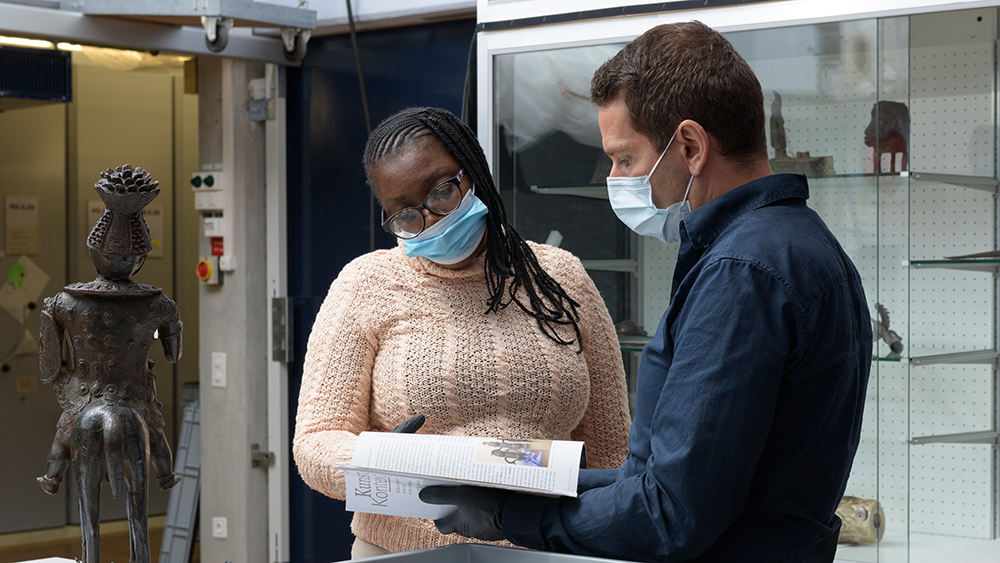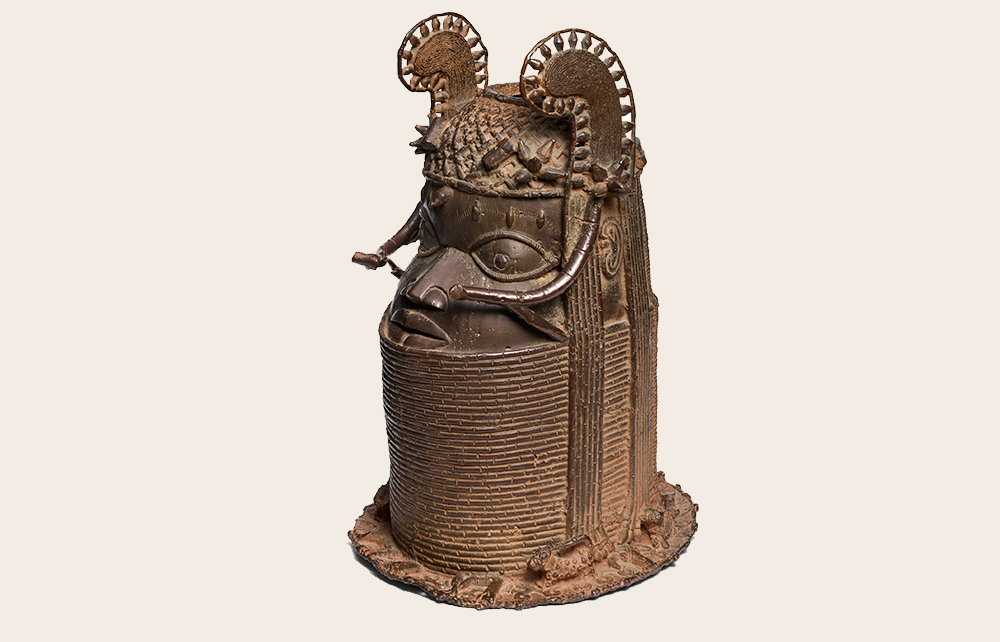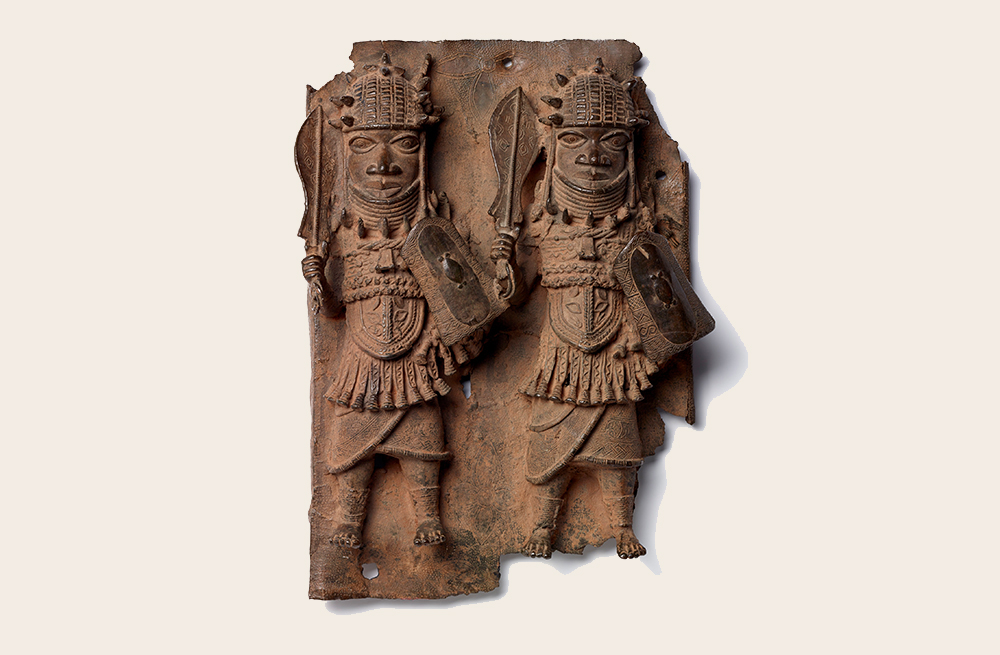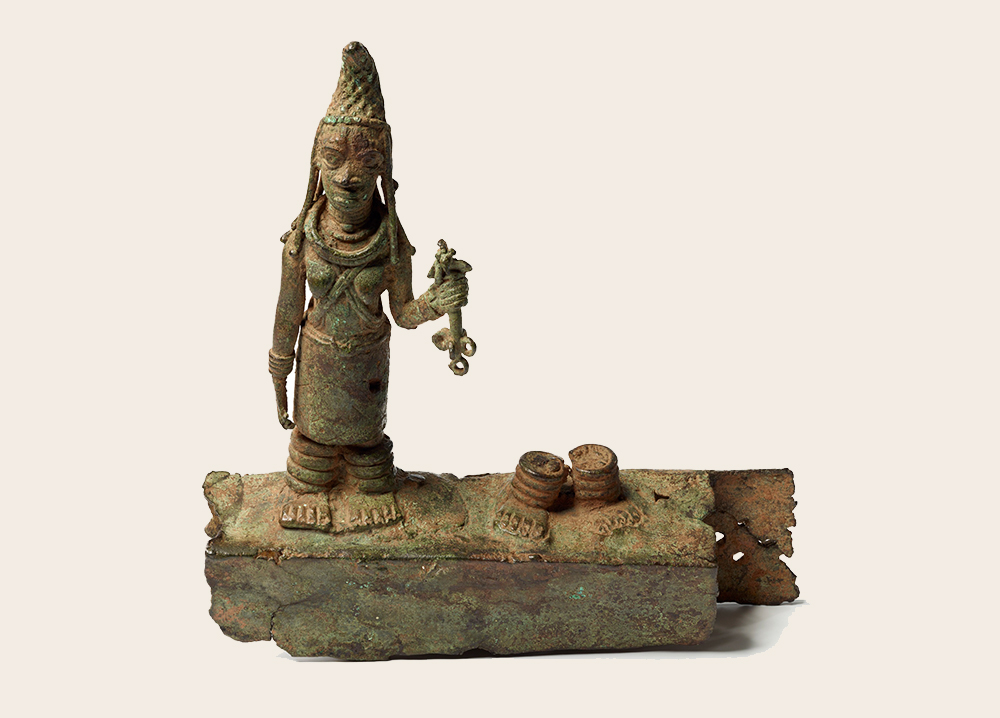Navigation auf uzh.ch
Navigation auf uzh.ch

In 1897, British colonial troops sacked the capital of the kingdom of Benin in modern-day Nigeria, seizing all royal treasures and burning the royal palace to the ground. Thousands of artefacts were looted. These objects were later auctioned off and made their way into museums and private collections around the world. Some 100 of these “Benin Bronzes” are currently also held by Swiss museums, including 18 in the Ethnographic Museum of the University of Zurich. The Swiss Benin Initiative (see box) investigated whether these items were among the looted objects from the kingdom of Benin.
Alexis Malefakis: The question of how colonial-era objects should be dealt with has been on our minds for some time, and the topic is now also being discussed by a wider public. Since Swiss museums also hold objects that are believed to have been looted during the 1897 assault, we want to do the responsible thing and set off research efforts and start a dialogue on this sensitive issue of cultural heritage – among experts in the field and with our partners in Nigeria.
They refer to a group of sculptures, some made of bronze but more often brass or other alloys, which include commemorative heads and cast plaques. Most of the commemorative heads show the heads of deceased kings. These works stood on altars, where the kings would honor their ancestors. This created a kind of ancestral gallery that recorded the royal lineage and legitimized the current king’s reign. The objects thus have great spiritual and political significance. The plaques, which decorated certain areas of the royal palace, documented key historical events such as wars or visits from foreign dignitaries. They were the kingdom’s archive and cultural memory. But the Benin Bronzes also include objects made of ivory, wood and other materials related to the kingdom of Benin.
The so-called Benin Bronzes cover a wide range of objects, and the Swiss Benin Initiative is about more than just the objects made of bronze. Moreover, some of the objects can’t be clearly attributed to the kingdom of Benin. For some of the objects in the museums, it’s unclear whether they actually originate there, or whether they were simply produced in the same way, for example in a neighboring region. It’s also often not clear whether they were created before or after the British invasion.
Absolutely. The historical kingdom of Benin had a long history of exchange and trade with the Global North from the 15th century onwards, especially with Portugal, with which metals, pepper and slaves were traded. Royal objects were also occasionally traded before the colonial war, for example when a king gave their European trading partner a gift. And then many fakes also appeared on the thriving market for Benin Bronzes that developed in Europe after 1897.

The objects we investigated were put into four categories: objects looted in 1897, objects likely to have been looted in 1897, objects unlikely to have been looted, and objects not looted in 1897. Fourteen of the 18 objects held by the Ethnographic Museum fell into the category of likely looted objects, while the others weren’t or are unlikely to have been looted.
No, and we have to learn how to deal with this. The Ethnographic Museum’s objects that were likely looted are from the collection of the Swiss collector Han Coray, who compiled a large collection of African artworks in the 1920s. He never traveled to Africa himself, but purchased the objects on the European art market. We managed to trace the origins of a few objects to other European collections, but often that’s where the trail ends.
Provenance researchers can tell a lot from the objects themselves. The literature distinguishes between different periods based on elements of style, and this allows researchers to give a rough estimate of when an object was created. Enibokun Uzébu-Imarhiagbe, a Nigerian historian involved in the project, met with researchers on site as well as with members of the bronze casting guild to discuss and categorize the objects. Very old objects that also have great spiritual value, for example, are unlikely to have been given away voluntarily.

This illustrates the cultural shift that’s currently taking place in museums and the general public. When it comes to African collections in Europe, there was a phase when objects were primarily understood from an aesthetic perspective and collected as art. The objects’ exact origins or the names of who created and used them were of little interest, and so this information wasn’t documented. Often the individual objects’ documentation reveals little more than where and how they were made. Today, however, we want to know who made the objects because we see it as our responsibility to let their descendants know that a part of their cultural heritage is being kept in our museums. Provenance research is really only the first step of the process.
The Swiss Benin Initiative’s research project was at first focused on providing clarity about the provenance of the objects. Now that we’ve looked into the past, we have to think about what significance the collection has in the present and in the future, and how we want to deal with this. These are questions that we don’t want to answer on our own, but by engaging in a dialogue with the communities of origin. Our report provides a crucial basis for this.
Overall, there is now a great willingness of all involved parties to meet restitution demands. But since the lack of documentation means it’s often not entirely clear where the objects came from, which specific village or region, for example, returning them outright isn’t such a simple matter. We need the expertise of the people in the communities of origin. Today it’s important for us that we declare that these collections are in our holdings and then work with the local people to decide what should ideally be done with the objects. The next step involves clarifying the legal situation and finding out whether restitution, if wanted, is possible.
Just because Europeans exhibit objects of cultural heritage doesn’t mean this has to be the case elsewhere. By putting an object in a museum, we’re ultimately removing it from use. But in its community of origin, an object’s significance may well be that something is done with it, that it’s touched and used. Personally, I think we Europeans shouldn’t tell other societies how they ought to handle their history and their cultural heritage – that’s for them to decide.

We are currently holding a workspace series called “5 questions on the collections” to make collections that have a range of sensitive objects accessible to the public. We’ve also just had a project approved by the Federal Office of Culture that focuses on objects from China held in ethnographic collections in Switzerland that may have been looted during the Boxer Rebellion in Beijing 1900/01. Mareile Flitsch, the museum’s director, is working together with Chinese guest curator Yu Filipiak on developing a workspace exhibition called Looted Goods?, which will open on 2 March. In addition, we’re in the process of hiring for our first permanent position for provenance research, which will be fully dedicated to the topic.
The research, even for only one object, can be very time-consuming. When a relatively small museum like the Ethnographic Museum of the University of Zurich has around 50,000 objects, you have to prioritize and be realistic about what can be accomplished in the foreseeable future. But the museums are highly motivated to address the issue of provenance. A lot will happen in the coming years, and that’s a good thing.